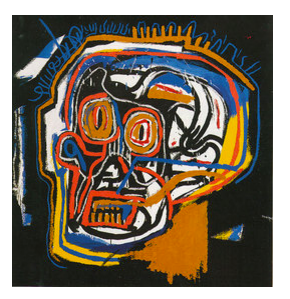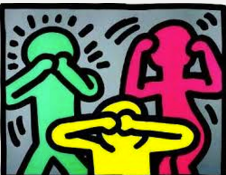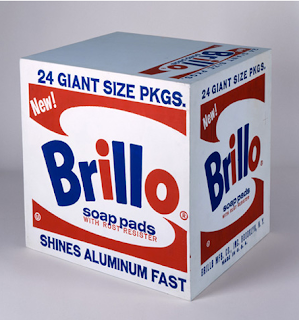 |
Charles the first, Jean- Michael Basquiat, 1982
|
Jean-Michael Basquiat's artistic endeavors were short lived, as he left this earth prematurely at the age of 28. His work exploded on the New York seen only shortly before his untimely death, but in that short time he took the art of graffiti leaps and bound beyond, blurring the lines between street and high art. Homeless when he was discovered, and taken under the wing of famed Pop artist Andy Warhol, Basquiat was instantly thrown into the lime light of the creative industry in the middle of the art mecca of the time.His alias SAMO, tells of his beliefs of the art world; "same old, same old". His work tells an important story of poverty, race and culture of his time.
Just a Basquait blurred the lines of what the meaning of art and value was in New York City in the 80's, my lines of understanding and acceptance become blurred once again. I continue an inner struggle with technology and the digitization of our world. The allowances of 'creativity and artistic ability are judged through my passion for a craft that is seemingly being borrowed every second of the day. This week, I let my passion for a community of people that struggle to become known, to make their art their life's work without starving, close my eye's and shut out acceptance.
My head gets a little crazy...
 |
| Head, 1983 |
There was a line in our reading that I had to read several times, up to that point I was had become a head nodder, in acceptance, feverishly taking notes of things that struck me in awe, that I LOVED, Then there was this line:" the possibility of drawing on existing media to resourceDIY media projects mean it is quite possible for the everyday person to cre-ate a polished product without necessarily being “artistic"( Lankshear and Knobel. (2008). WHAT? Yes, it is true, all the technology and digital Apps and programs make just about everything accessible to everyone, but creating polished products without being artistic? NO! What is happening is that people are being led to believe that they are suddenly artists, without any creativity. And that lack of creativity is what will always separate those who possess artistic talents and those that are just riding coat tails. An app, a program only allows you to create what the creator of that app or program allows you to create, you are constrained to the creators ability and creativity. Without artistic ability, you will have a sub-par product, this is the difference between the business cards you can't seem to stop looking at, and the ones that get lost in the bottom of your desk.
I struggle through the rest of the reading, ever present is this notion of art and artistry that I can't let go, I feel myself falling apart and regressing to my younger self pre-technology. My second daily create reflects my mindset as I use the opportunity to inform my peers of the creator of stop motion film, re-birthing Muybridges walk, whilst everyone else uses the technology of the day to create 'cute' little films of themselves walking around. My music is purposeful- 'I walk the line", striped of color and feeling, this is where technology started.
Simplicity and Focus regained- " I don't think about art when I am working, I try to think about life" Jean -Michael Basquiat.
 |
Untitled (Sugar Ray Robinson)-1982
|
Sometimes we become so focused that we actually loose focus. It was at the Tedx conference this weekend that I am reminded how important that all this technology stuff is, that we continue to grow and develop as a community and species rather than lying stagnant. What would graffiti look like if the art never progressed past Taki183? Noted as the 'first' graffiti artist, Taki simply wrote his name, with a goal to have his mark in all 5 burrows of NYC. I see now the connection, we are all Taki's, and some of us are even a bit Basquiat creating better and more artistic marks that we leave behind. We all just want to share what we can do, to be noticed, and for someone to leave a comment.
In an expert talk, practical futurist Taylor Romero outlines he and his wife's success, all at the hands of technology and the digital age, because they opened their minds to the endless possibilities of being connected. He reminds the audience that anyone that doubts technology and 'hates' it should be riding a horse naked, and to that he would tip his hat, oh wait he couldn't because that would bring manufacturing into the conversation, and he would hate to offend. The crowd laughs hysterically, and there I realize that I have been kind of an ass this week.
I don't 'hate' technology, I am just getting used to the change. I have to remember all of the things that technology and being connected has brought me, my students and my craft. As my list of followers grows, the connections that I make become more valuable, conversations are used to help myself and others grow. This week I made a 'handshake' on twitter with @dogtrax, to the first person to figure out how to make a gif, a real one, not copy and paste, would teach the other person. This is what I need to remember about technology and artistry as I read about the accessibility of becoming a non artist.
Throughout my struggle with the topic, I continue to participate, though I still don't think that I have fully tackled the possibilities of what hypothesis is. I know that I write comments that I want to post to twitter, but then can't find them because they are part of a reply? I love connecting each week to an artist, and have not duplicated yet- there are so many to share, and inform the non artists and learning artist about, and remind the artist of the rich history that ha made so many changes to our culture. Basquiat is especially important, his work really impacted the art world, racially, economically and socially, which is a goal of mine with my students everyday.
I was a really lousy artist as a kid. Too abstract expressionist; or I'd draw a big ram's head, really messy. I'd never win painting contests. I remember losing to a guy who did a perfect Spiderman.
Do you think that the non artist drawing someone else's Superman is remembered by anyone? Use your own creativity to leave your mark, if you wish to be remembered.






























